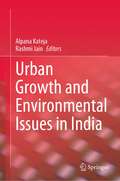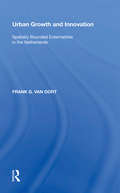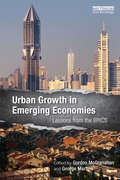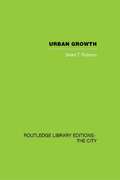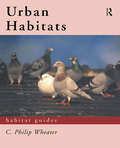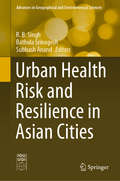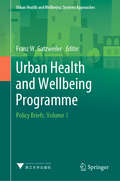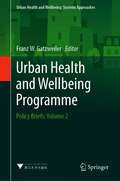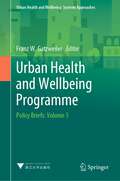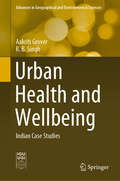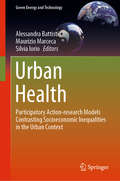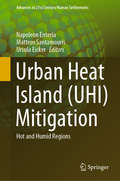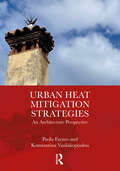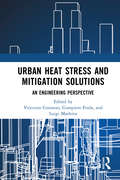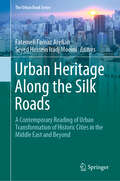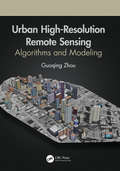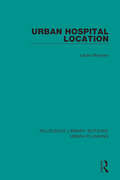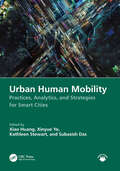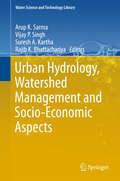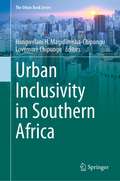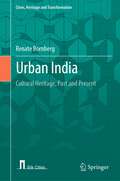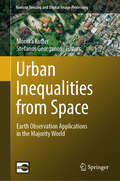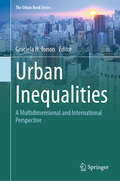- Table View
- List View
Urban Growth and Environmental Issues in India
by Rashmi Jain Alpana KatejaThis book examines the interplay between urban growth and the environmental issues in India. The contributors, who are coming from diverse disciplines, examine socioeconomic, administrative, and environmental threats emanating from urbanization (e.g. climate change, health governance, energy issues, pollution, and e-waste management) and suggest various measures for dealing with the challenges of rapid urbanization. Offering a valuable resource for all those interested in understanding the multifaceted dimensions of urban growth, the book appeals to researchers, students, and policymakers, interested in the development studies and urban studies.
Urban Growth and Innovation: Spatially Bounded Externalities in the Netherlands (Ashgate Economic Geography Ser.)
by Frank G. OortKnowledge externalities - i.e. intellectual gains made by exchange of information for which no direct compensation is given to the producer of the knowledge - result in higher economic growth rates across urban areas, as well as higher degrees of innovation intensity in those locations where economic activity is dense. By combining theories and methodologies on localised growth and innovation density from the fields of geography and economics, he puts forward an innovative spatial econometric model which contributes to a clearer understanding of actual processes of growth and innovation and their linkages to industry and spatially determined agglomeration factors. In doing so, the book acknowledges the increasing importance of geographical composition and distance for the transmission of knowledge and skills in a society in which information becomes easier to access.
Urban Growth in Emerging Economies: Lessons from the BRICS
by George Martine Gordon McGranahanAlong with globalization, urban transitions have been central in the southward shift in economic power towards the newly emerging economies. As this book shows, however, these transitions have not been painless, and it is important for the rest of the urbanizing world to learn from the mistakes. It examines the role of urbanization and urban growth in the emerging economies, taking the BRICS countries (Brazil, Russia, India, China and South Africa) as case studies. Their different approaches towards urbanization have shaped their historical development paths and assisted or constrained their futures. Several of the BRICS bear heavy burdens from past failures to accommodate urban growth inclusively and efficiently, and many other urbanizing countries in Asia and Africa are in danger of replicating their mistakes. The overriding lesson of the book is that cities and nations must anticipate urbanization, and accommodate urban growth pro-actively, so as not to be left with an enduring legacy of inequalities and lost opportunities. This book is aimed at students and researchers in urban studies and development studies. It will also be of interest to policy advisors concerned with urbanization and the role of cities in a country’s development
Urban Growth: An Approach
by Brian T. RobsonDo large cities grow more or less rapidly than small ones? Why should the relationship between city size and population growth vary so much from one period to another? This book studies the process of population growth in a national set of cities, relating its findings to the theoretical concepts of urban geography. To test his ideas, the author studies the growth of cities in England and Wales between 1801 and 1911. His explanations draw strongly on the connection between growth and the adoption of innovations. He develops a model of innovation diffusions in a set of cities and, in support of this model, looks at the way in which three particular innovations - the telephone, building societies and gaslighting - spread amongst English towns in the nineteenth century. This book was first published in 1973.
Urban Habitats (Habitat Guides)
by C. Philip WheaterThe author presents an illustrated and practical guide to the wide range of urban habitats and the flora and fauna that live within them. The important conservation and management issues presently being faced within our towns and cities are examined.Topics of concern to the conservationalist or habitat manager are explored, including:* the impact and monitoring of pollution* the effects of invasive species* guidelines for the ecological management of sites to enhance their nature conservation value.Urban Habitats is richly illustrated, features up-to-date references and data, and proposes a series of projects.
Urban Health Risk and Resilience in Asian Cities (Advances in Geographical and Environmental Sciences)
by R. B. Singh Bathula Srinagesh Subhash AnandThis book focuses on understanding urban vulnerability and risk mitigation, advancing good health and wellbeing, and analysing resilience measures for various Asian cities. Today, cities are the dominant human habitat, where a large number of environmental, social, cultural and economic factors have impacts on human health and wellbeing. Cities consist of complex, dynamic, socio-ecological, and technological systems that serve multiple functions in human health and wellbeing. Currently half of Asia’s population is urban, and that figure is expected to rise to 66 percent by 2050. Since urban areas are often most vulnerable to hazards, the people living in them need good health infrastructure facilities and technological support at various scales. As such, the need of the hour is to enhance the adaptive capacity, strengthen resilience, reduce vulnerability, and take risk mitigation measures in urban areas, which requires a systematic approach based on science–policy interface that is transformative, trans-disciplinary and integrative for a sustainable urban future. Global sustainable development goals are closely tied to urban human health and wellbeing: (1) the third of the United Nations’ Sustainable Development Goals is to “Ensure healthy lives and promote wellbeing for all at all ages” and (2) the eleventh is to “Make cities inclusive, safe, resilient and sustainable”. By addressing these goals, this book offers a highly useful resource for anyone concerned with healthy and resilient cities in Asia, today and tomorrow.
Urban Health and Wellbeing Programme: Policy Briefs: Volume 1 (Urban Health and Wellbeing)
by Franz W. GatzweilerThis book is a compilation of the policy briefs produced by the International Science Council’s program on Urban Health and Wellbeing: A Systems Approach over the past five years. Intended for urban decision-makers at all levels, it highlights policy-relevant findings and research insights to encourage the co-creation of knowledge for healthy urban environments and people. The book shows how variations on the systems approach developed and promoted by the program have been implemented in regions around the world and contributed to improving urban health. These policy briefs summarize research findings and scientific events concerning urban health-related topics that are relevant for public health professionals, urban planners, urban stakeholder groups and the public at large.
Urban Health and Wellbeing Programme: Policy Briefs: Volume 2 (Urban Health and Wellbeing)
by Franz W. GatzweilerThis book is a collection of policy briefs produced from research presented at the 16th Conference on Urban Health in Xiamen, China, November 4–8, 2019, under the theme “People Oriented Urbanisation: Transforming Cities for Health and Well-Being”, co-organized by the Urban Health and Wellbeing (UHWB) programme of the International Science Council (ISC). The UHWB programme takes an interdisciplinary, cross-sectoral and systemic view on issues of health and wellbeing in cities which include the urban economy and finance systems, education, employment, mobility and transport, food, energy and water resources, access to public services, urban planning, public spaces and urban green, as well as social inclusion. Contributions to this book have been made by scientists from multidisciplinary research fields. The policy briefs in this book present the background and context of an urban health issue, research findings and recommendations for policy/decision-makers and action-takers. In some cases, they inform about relevant events and developments from the science community or important opinion pieces which address health emergencies, like the current COVID-19 pandemic. The book is intended for citizens and political decision-makers, who are interested in systems perspectives on urban health and wellbeing, examples of how to deal with the increasing complexity of cities and the accompanying environmental and social impacts of increasing urbanization. Furthermore, it hopes to inspire decision-makers to facilitate finding solutions, in order to reach the goal of advancing global urban health and wellbeing.
Urban Health and Wellbeing Programme: Policy Briefs: Volume 3 (Urban Health and Wellbeing)
by Franz W. GatzweilerThis book presents the background and context of an urban health issue, research findings, and recommendations for policy/decision-makers and action-takers. This book is a collection of policy briefs produced from research presented at the 16th Conference on Urban Health in Xiamen, China, during November 4–8, 2019, under the theme “People Oriented Urbanisation: Transforming Cities for Health and Well-Being,” co-organized by the Urban Health and Wellbeing (UHWB) programme of the International Science Council (ISC), The 15th Annual Session of Global Forum on Human Settlements in Shenzhen, China, during October 15–16, 2020, and the Chinese Academy of Sciences & Technology (CAST) International Conference on "Digital economy and green development" held during November 2020. The UHWB programme takes an interdisciplinary, cross-sectoral, and systemic view on issues of health and well-being in cities which include the urban economy and finance systems, education, employment, mobility and transport, food, energy and water resources, access to public services, urban planning, public spaces and urban green, as well as social inclusion. Contributions to this book have been made by scientists from multidisciplinary research fields. The policy briefs in this book provide an interdisciplinary and cross-sectoral perspective on urban health and human well-being issues, primarily food security, urban infrastructure, public services, traffic and transportation, smart city building, urban health and safety, social cohesion sustainable development policies, and urban planning. In some case, it informs about urban health issues in different regions of the world, the current status, and key insights into addressing related issues, with emphasis on factual cases in the current COVID-19 pandemic. The book is intended for citizens and political decision-makers, who are interested in systems perspectives on urban health and well-being, examples of how to deal with the increasing complexity of cities and the accompanying environmental and social impacts of increasing urbanization. Furthermore, it hopes to inspire decision-makers to facilitate finding solutions, in order to reach the goal of advancing global urban health and well-being.
Urban Health and Wellbeing: Indian Case Studies (Advances in Geographical and Environmental Sciences)
by R.B. Singh Aakriti GroverThis book focuses on interdisciplinary issues of human health in the changing urban environments of India’s largest megacities—Delhi and Mumbai. The authors explore human health concerns related to increased temperatures and air pollution in these cities in a study based on primary data collected through interviews, as well as secondary data on causes of mortality from 2001 to 2012. During this period, the surface temperatures for both megacities were mapped using Landsat Images.The rapidly increasing populations of cities and urban centers alter ecosystem services such as water, air and land cover, with disastrous impacts on health and wellbeing, particularly in megacities. In 2015, polluted air was estimated to have been responsible for 6.4 million deaths worldwide, and it is projected that it will cause between 6 and 9 million deaths per year by 2060. In 2017, outdoor air pollution resulted in 1.2 million deaths in India and brought about a 3% loss in GDP. The increase in population, vehicles, and industries has led to changes in land use and land cover and a rise in city temperatures and air pollution, creating urban heat islands (UHIs). Together, UHIs and air pollution have damaging impacts on human health that range from stress and headache to asthma, bronchitis, and chronic diseases, and even to death.Delhi has been experiencing emergency conditions in terms of environmental health over the past two years. At the same time, both the Delhi and Mumbai urban agglomerations are growing at a rapid pace, and the United Nations has projected that they will be the second and third most populous cities in the world by 2025. In this context, the book offers significant insights into the past patterns and responses to the present global urban health emergencies, and explores sustainable means of combating the problem to enable college and university researchers to develop innovative solutions. Further. It presents trans-disciplinary research that cuts across the WHO Action Plan, the Sustainable Development Goals, the Sendai Framework for Disaster Risk Reduction, and Habitat III to help policymakers gain a better understanding of the global challenges of urban health and wellbeing. The book is especially useful for students and researchers in geography, urban demography, urban studies, environmental studies, health sciences, and policy studies.
Urban Health: Participatory Action-research Models Contrasting Socioeconomic Inequalities in the Urban Context (Green Energy and Technology)
by Alessandra Battisti Maurizio Marceca Silvia IorioThis book qualitatively and quantitatively examines the relationships between the constructed environment, health and social vulnerability. It demonstrates that spatial disintegration is often intertwined with health and social inequalities, and therefore a multidisciplinary approach to urban health is essential in order to analyze the impact that psycho-social-environmental factors can have on objective, and perceived health and to investigate the inequalities in healthcare and medical assistance processes. Empirical relationships have been observed between urban environment, social vulnerability and health in different contexts, however there is still a lack of standardized tools that allow us to gain a clear understanding of how health inequalities and daily life are generated. In order to address this issue, a national network of active research groups has been created to draft and develop a prototypical analysis infrastructure to facilitate empirical studies aimed at shedding light on the complex relationships between health disparities, socio-environmental and economic distress, as well as personal and collective health. Given the interest in achieving meaningful, fair and lasting solutions to health inequalities, and the current lack of an analytical system, there is the need for new multidisciplinary approaches oriented toward the quality of life within a eco-social model of health. Providing an overview of the methodological approaches discussed, this book will appeal to researchers. At the same time it allows those working in local and government social care, healthcare and administrative institutions to gain insights into best practices in urban contexts.
Urban Heat Island: Hot and Humid Regions (Advances in 21st Century Human Settlements)
by Ursula Eicker Napoleon Enteria Matteos SantamourisThis book discusses the concepts and technologies associated with the mitigation of urban heat islands (UHIs) that are applicable in hot and humid regions. It presents several city case studies on how UHIs can be reduced in various areas to provide readers, researchers, and policymakers with insights into the concepts and technologies that should be considered when planning and constructing urban centres and buildings. The rapid development of urban areas in hot and humid regions has led to an increase in urban temperatures, a decrease in ventilation in buildings, and a transformation of the once green outdoor environment into areas full of solar-energy-absorbing concrete and asphalt. This situation has increased the discomfort of people living in these areas regardless of whether they occupy concrete structures. This is because indoor and outdoor air quality have both suffered from urbanisation. The development of urban areas has also increased energy consumption so that the occupants of buildings can enjoy indoor thermal comfort and air quality that they need via air conditioning systems. This book offers solutions to the recent increase in the number of heat islands in hot and humid regions.
Urban Heat Mitigation Strategies: An Architecture Perspective
by Paola Favaro Konstantina VasilakopoulouUrban Heat Mitigation Strategies: An Architecture Perspective explores heat mitigation strategies integrated into the urban architecture of global cities, aiming to enhance citizens’ quality of life through thoughtful design decisions blending architecture, science and engineering. The projects examined exemplify top-tier approaches in architecture, urban planning, landscape design and engineering across diverse city precincts worldwide. Inspired by architect and urban designer Lewis Mumford’s 1970s call for urban spaces that support citizens, these initiatives focus not just on aesthetics but also on effective social and climate change mitigation strategies.Featuring international urban projects recognised for both architectural significance and improved thermal comfort, this book examines the various heat mitigation strategies in major urban projects using architectural and engineering methodologies. Combining architectural formal/critical analysis with engineering performance modelling, the authors offer qualitative and quantitative assessments of each urban project. These projects showcase best practices utilising elements such as water, materials, vegetation and canopy to mitigate heat and promote civic life. Originally intended for aesthetics and social functionality, these strategies now serve as benchmarks for creating thermally comfortable public spaces globally.Relevant to architects, city planners, landscape designers and engineers, Urban Heat Mitigation Strategies: An Architecture Perspective promotes successful collaboration among built environment professionals to address climate concerns and create liveable, comfortable urban spaces.
Urban Heat Stress and Mitigation Solutions: An Engineering Perspective
by Vincenzo CostanzoThis book provides the reader with an understanding of the impact that different morphologies, construction materials and green coverage solutions have on the urban microclimate, thus affecting the comfort conditions of urban inhabitants and the energy needs of buildings in urban areas. The book covers the latest approaches to energy and outdoor comfort measurement and modelling on an urban scale, and describes possible measures and strategies to mitigate the effects of the mutual interaction between urban settlements and local microclimate. Despite its relevance, only limited literature is currently devoted to appraising—from an engineering perspective—the intertwining relationships between urban geometry and fabrics, energy fluxes between buildings and their surroundings, outdoor microclimate conditions and building energy demands in urban areas. This book fills this gap by first discussing the physical processes that govern heat and mass transfer at an urban scale, while emphasizing the role played by different spatial arrangements, manmade materials and green infrastructures on the outdoor microclimate. The first chapters also address the implications of these factors on the outdoor comfort conditions experienced by pedestrians, and on the buildings’ energy demand for space heating and cooling. Then, based upon cutting-edge experimental activities and simulation work, this book demonstrates current and forthcoming adaptation and mitigation strategies to improve the urban microclimate and its impact on the built environment, such as cool materials, thermochromic and retroreflective finishing materials, and green infrastructures applied either at a building scale or at the urban scale. The effect of these solutions is demonstrated for different cities worldwide under a range of climate conditions. Finally, the book opens a wider perspective by introducing the basic elements that allow fuel poverty, raw materials consumption, and the principles of circular economy in the definition of a resilient urban settlement.
Urban Heritage Along the Silk Roads: A Contemporary Reading of Urban Transformation of Historic Cities in the Middle East and Beyond (The Urban Book Series)
by Fatemeh Farnaz Arefian Seyed Hossein Iradj MoeiniThis book examines examples of contemporary situation of historic regions in the Middle East and its broader geographic context connected to the historic trade routes, offering cross-disciplinary and cross-sectoral perspectives. The region is home to ancient settlements and early human endeavors to form cities, and across the region historic urban historic features, such as ancient city centers, still exist alongside contemporary ones. Many of those historic regions are along the Silk Roads. However, the urban continuity that once existed over generations in the physical and social paradigm have been interrupted by rapid urbanization, globalization and urban economic pressures, in addition to conflicts and frequent destructive natural hazards. It is often the case that dealing with such pressing issues in a historic city is more complex than dealing with those in newly built cities and urban areas. Based on carefully selected and updated papers from the Silk Cities 2017 International Conference, this book appeals to researches, practitioners and policy makers.
Urban High-Resolution Remote Sensing: Algorithms and Modeling
by Guoqing ZhouWith urbanization as a global phenomenon, there is a need for data and information about these terrains. Urban remote sensing techniques provide critical physical input and intelligence for preparing base maps, formulating planning proposals, and monitoring implementations. Likewise these methodologies help with understanding the biophysical properties, patterns, and process of urban landscapes, as well as mapping and monitoring urban land cover and spatial extent. Advanced sensor technologies and image processing methodologies such as deep learning, data mining, etc., facilitate the wide applications of remote sensing technology in urban areas. This book presents advanced image processing methods and algorithms focused on three very important roots of urban remote sensing: 3D urban modelling using different remotely sensed data, urban orthophotomap generation, and urban feature extraction, which are also today’s real challenges in high resolution remote sensing. Data generated by remote sensing, with its repetitive and synoptic viewing and multispectral capabilities, constitutes a powerful tool for mapping and monitoring emerging changes in the city's urban core, as well as in peripheral areas. Features: Provides advances in emerging methods and algorithms in image processing and technology Uses algorithms and methodologies for handling high-resolution imagery from a ground sampling distance (GSD) less than 1.0 meter Focuses on 3D urban modelling, orthorectification methodologies, and urban feature extraction algorithms from high-resolution remotely sensed imagery Demonstrates how to apply up-to-date techniques to the problems identified and how to analyze research results Presents methods and algorithms for monitoring, analyzing, and modeling urban growth, urban planning, and socio-economic developments In this book, readers are provided with valuable research studies and applications-oriented chapters in areas such as urban trees, soil moisture mapping, city transportation, urban remote sensing big data, etc.
Urban Hospital Location (Routledge Library Editions: Urban Planning #16)
by Leslie D MayhewOriginally published in 1986 Urban Hospital Location examines the rising costs of health care and how the problem of providing a cost-effective and equitable pattern of health services is now a vital issue in many countries. It looks at how location decisions are especially difficult in cities because of the shifting geographical distribution and demographic structure of urban populations. The book shows how the utilisation of health services is strongly influenced by their location and argues that better geographical organisation of health care facilities would contribute significantly to a better and more effective health service.
Urban Human Mobility: Practices, Analytics, and Strategies for Smart Cities
by Kathleen Stewart Xinyue Ye Subasish DasThis comprehensive handbook covers human mobility within urban contexts, integrating academic theories with pragmatic insights and offering a detailed analysis of the diverse facets of human mobility and its substantial impact on the urban landscape, economy, and societal structures. It explains key fundamental concepts, methods, and models, presenting an in-depth exploration of predictive analytics, clustering patterns, advanced trajectory embedding techniques, artificial intelligence, machine learning, geographic information systems (GIS), Internet of Things (IoT), and smart city innovations. The authors include many case studies and examples of urban mobility in practice, making the content relatable and practical for educators, students, researchers, and practitioners. Features Provides a multidisciplinary and holistic understanding of urban mobility with systematic introductions and discussions of theory, methods, technologies, tools, and applications. Covers a wide range of real-world case studies of urban mobility in practice globally that include data, programming code, and tools. Discusses cutting-edge technologies involved in mobility data analytics. Addresses practical challenges in data collection and the ethical implications of mobility research, which are crucial for professionals in the field. Offers future directions of human mobility research under the big data and artificial intelligence (AI) revolution. Urban Human Mobility: Practices, Analytics, and Strategies for Smart Cities is for professionals, academics, and upper-level undergraduate and graduate students in the fields of urban planning/design, GIScience, data mining, and social sciences.
Urban Hydrology, Watershed Management and Socio-Economic Aspects
by Vijay P. Singh Arup K. Sarma Suresh A. Kartha Rajib K. BhattacharjyaThe book brings together high-quality research articles on advanced hydrological analysis, advanced computational methods, and the ecological and sociological aspects of urban watershed management under one umbrella. The rapid pace of urbanization, not accompanied by any farsighted, holistic plan, has reduced many cities in the developing world into multi-hazard areas. The most perceptible consequence of urbanization is the change in land-use and land cover, which in turn impacts hydrological systems. Accordingly, scientific studies on urban hydrology with due emphasis on ecological and sociological aspects under changing climate are vital to the appropriate design of urban landscapes and civil infrastructure works. This book addresses precisely these issues, offering a useful guide for environmentalists, hydrologists, and a broad range of socio-economic scientists exploring the environmental vulnerabilities arising from urbanization.
Urban Inclusivity in Southern Africa (The Urban Book Series)
by Lovemore Chipungu Hangwelani H. Magidimisha-ChipunguThis book’s point of departure rests on the premises that dimensions of the mainstream inclusive city discourse fail to capture in detail vulnerable clusters of society (being women, children, and the aging), the minority clusters (i.e., the blind, the disabled), and migrants. In addition, it fails to recognize the increase of spatial inequality driven by racial and class differences—a factor that has seen an increase in community violence and protests. The focus on spatial inequality has, for a long time, blind-folded urban authorities to ignore exclusion arising out of the same environments created with a notion of creating inclusivity. Hence this book “collapses spatial walls” as it seeks to uncover the true perspectives of inclusivity in cities beyond spatial dimensions but within social realms. The depth of this book’s enquiry rests on its critical investigation of Southern African cities’ through historical epochs of apartheid and colonialism in the region.
Urban India: Cultural Heritage, Past and Present (Cities, Heritage and Transformation)
by Renate BornbergThis book discusses the importance of socio-spatial patterns in cities that are embedded in the cultural heritage and self-understanding of a society, showing that Indian cities follow different urban concepts. In nine episodes (nine is a sacred figure), it highlights the principal influences and social impacts on cities from ancient times to contemporary city developments. As such, it provides planners and architects with insights that can easily be applied in contemporary cities and towns and help foster India’s cultural heritage—a much-needed, but little-discussed approach.Indian cities are the result of various factors, some imposed, others following local traditions that shaped them. They were founded around social needs, landscape conditions and production routines, as well as the religious influences of Hinduism, Buddhism, Jainism, Sikhism, Islam, Christianity and animism. However, Western town-planning models are often implemented, blurring the traditional way of life in cities. For sustainable town development, it is of key importance to find solutions that deal with Indian city models.
Urban Inequalities from Space: Earth Observation Applications in the Majority World (Remote Sensing and Digital Image Processing #26)
by Monika Kuffer Stefanos GeorganosRapid transformation processes occur in the Majority World, where most of the global population is living (estimated around ¾ of the global population), often deprived of access to infrastructure, services, exposed to hazards and degrading environmental conditions. The continuous urbanization in many African, Asian and Latin American cities is coupled with rapid socio-economic and demographic changes in urban, peri-urban, and rural areas. These changes often increase socio-economic fragmentation and existing disparities. According to the United Nations, of the 36 fastest growing cities (with an average annual growth rate of more than 6%), seven are located in Africa, while 28 are found in Asia. On top of the socio-economic transformations, the increasing impact of climate change is expected to increase local vulnerabilities. However, data to understand these transformation processes and relationships are either unavailable, scarce or come with high degrees of uncertainty. Earth Observation information and methods have a great potential to fill data gaps, but they are not exploited to their full potential. Most urban remote sensing studies in the Majority World focus on the primary cities, while not much is known about secondary cities, urbanizing zones or peri-urban areas. Attempting to measure and map environmental and socio-economic phenomena through remote sensing is fundamentally different from extracting bio-physical parameters. In general, studies done by researchers of the Minority World do not sufficiently understand the information needs and capacity demands of the Majority World, especially related to user requirements and ethical perspectives. In this book, we aim to provide an outlook on how Remote Sensing can provide tailored solutions to information needs in urban and urbanizing areas of the Majority World, e.g., in terms socio-economic, environmental and demographic transformation processes. We will provide methodological and application pathways insupport of local and national information needs as well as in support of sustainable development, and specifically, supporting the monitoring of the 17 Sustainable Development Goals (SDGs). The book combines an overview of innovations in applications, methodologies and data use, showing the capacity of Earth Observation to fill global knowledge gaps.
Urban Inequalities: A Multidimensional and International Perspective (The Urban Book Series)
by Graciela H. TononThis book proposes an interdisciplinary and multidimensional perspective of urban inequalities based on a range of theoretical, methodological, and professional approaches. Chapters consider different types of inequalities: in health, education, age, housing, energy, space, civic rights, social exclusion, ethnicity, poverty, segregation, work status, nutrition, public policies, democracy, human rights, technology, digital learning, subjective well-being, environment, and climate change. Contributions analyze the situation of different groups: children, youth, and indigenous people. The book highlights the importance of policy-making to overcome inequalities and addresses the key role of citizen participation.
Urban Inequality and Segregation in Europe and China: Towards a New Dialogue (The Urban Book Series)
by Houkai Wei Yu Chen Ya Ping Wang Gwilym Pryce Jingjing ShanThis open access book explores new research directions in social inequality and urban segregation. With the goal of fostering an ongoing dialogue between scholars in Europe and China, it brings together an impressive team of international researchers to shed light on the entwined processes of inequality and segregation, and the implications for urban development. Through a rich collection of empirical studies at the city, regional and national levels, the book explores the impact of migration on cities, the related problems of social and spatial segregation, and the ramifications for policy reform. While the literature on both segregation and inequality has traditionally been dominated by European and North American studies, there is growing interest in these issues in the Chinese context. Economic liberalization, rapid industrial restructuring, the enormous growth of cities, and internal migration, have all reshaped the country profoundly. What have we learned from the European and North American experience of segregation and inequality, and what insights can be gleaned to inform the bourgeoning interest in these issues in the Chinese context? How is China different, both in terms of the nature and the consequences of segregation inequality, and what are the implications for future research and policy? Given the continued rise of China’s significance in the world, and its recent declaration of war on poverty, this book offers a timely contribution to scholarship, identifying the core insights to be learned from existing research, and providing important guidance on future directions for policy makers and researchers.
Urban Informality in South Africa and Zimbabwe: On Growth, Trajectory and Aftermath (The Urban Book Series)
by Inocent Moyo Trynos GumboThis book adds to the research of urban informality in the Global South with a specific focus on South Africa and Zimbabwe. It addresses the agency and the potential transformative capacity of the phenomenon of urban informality in connection with Southern African cities and towns. It adopts a political economy approach to analyse the evolution of informality in cities and its implications for urban planning. It brings to bear how the South African and Zimbabwean historical and/or ideological and contemporary political and economic trajectories have impacted on the ever changing nature of urban informality, both spatially and structurally and/or compositionally; thus resulting in unique urban materialities, which are aspects that have scarcely been studied or discussed in the extant literature. This book, therefore, seeks to close the academic gap by dealing with the dearth of literature on spatial (re)locational discourses of urban informality.The work positions urban informality as a resilient force with potency in terms of political mobilisation and (re) shaping urban spaces. Though these are fundamental issues, they have received comparatively little attention, especially in literature that focuses on the Southern African region. Accordingly, undergraduate and post-graduate students, as well as academics in the fields of Urban Geography, Political Science, Development Studies, Sociology, Town and Regional Planning among others, will find the range of topics and depth of coverage in this book particularly valuable. Similarly, practitioners and activists on issues of urban informality and urban governance will find the book very useful.
